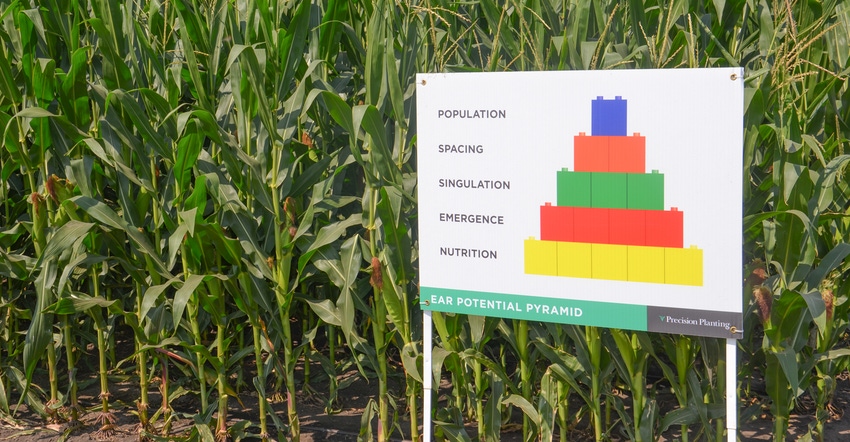
A sign at the Precision Planting test farm near Pontiac, Ill., carries a key message. Stacey Lewis with Precision Planting calls it the “yield pyramid.” Soil nutrition forms the base, followed by emergence, singulation, plant spacing and population. Get them all right, and you should harvest as many ears and kernels per acre as possible, Lewis says.
All but one relates directly to good planter preparation. If you haven’t started yet, you’re probably behind the curve, notes Phil Jennings, service manager for Kinze. The sooner you make sure both physical and technological components are in top shape, the more likely you’ll be ready to go after top yields at planting.
Planter math
Here’s how quickly you can fail to reach the top of Lewis’ yield pyramid based on maximum number of ears per acre.
• Each skip counts. Data based on work by Precision Planting suggests that for each skip, you lose 80% of an ear per acre. You don’t lose the full ear because plants on either side compensate. But corn’s ability to compensate pales in comparison to a soybean plant’s compensation power. Estimates say neighboring corn plants can each add 10% more yield than normal, or 20% total — hence still an 80% loss.
• Doubles carry a cost. The same data says if the planter drops a double, you still lose 40% of an ear compared to two plants spaced properly.
• Ears per acre matter. Most sources agree that an extra 1,000 ears per acre means about 7 more bushels per acre. Here’s the math, using the yield estimation formula in the Purdue University Corn and Soybean Field Guide.
Assume 30,000 ears per acre, with 18 rows of kernels, 36 kernels per row and a “fudge factor” for kernels per bushel of 85. The math is: 30 times (18 times 36) equals 19,440 divided by 85 equals 228.7 bushels per acre.
Suppose you did a superb job of planter prep and upped population to 31,000. Everything else remaining constant, the math is: 31 times (18 times 36) equals 20,088 divided by 85 equals 236.3 bushels an acre — an increase of more than 7 bushels per acre.
• Rows per ear count. Genetics heavily impacts number of rows per ear. Yet suppose that due to proper spacing, even emergence and other factors, most ears have 18 rows instead of 16.
In the example above with 30,000 ears per acre and 18 rows of kernels per ear, 36 kernels per row, yield was 228.7 bushels per acre. What happens if there are only 16 rows, with everything else staying constant?
The math is: 30 (16 times 36) equals 17,280 divided by 85 equals 203.5 bushels per acre. That’s roughly 25 bushels per acre less in this simplistic example.
• Kernels per row make difference. Suppose there were 37 kernels per row instead of 36 on each ear in the original example. The math is: 30 times (18 times 37) equals 19,980 divided by 85 equals 235 bushels per acre, or about 6 more bushels per acre.
That agrees with Precision Planting data that suggests each extra kernel per row per ear is worth about 6 bushels per acre.
About the Author(s)
You May Also Like




